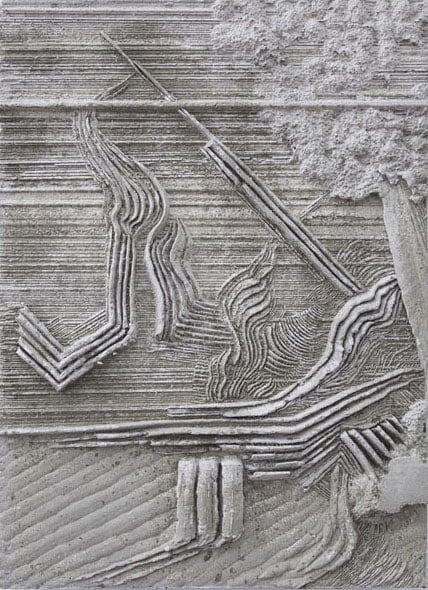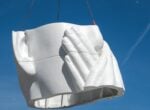Luca Monterastelli – Weightless

In Weightless i nuovi lavori scultorei di Monterastelli s’interrogano su quel che passa dalla gravità al “pesare nulla” (come recita il titolo della personale).
Comunicato stampa
The art of Luca Monterastelli (Forlimpopoli, 1983) takes its cue from some of the fundamental principles of sculpture, among which the artist himself includes “weight, the transferability of our energy onto an object-body, our perception of the three dimensions, and the relationship between surface and mass”. And he does so by using a variety of materials, such as plaster, terracotta, cement, and iron, for the metaphorical potential for transformation inherent in each one, but also for the symbolic and political value of the way they have been used down the ages. He de-constructs forms in order to rewrite them in a free-for-all of narrative tension.
In Weightless, Monterastelli’s new sculptural works question the shift from gravity to “weightlessness”, as the title suggests. “I want to examine how memory works,” he says, “and explore the origins of the narrative and its inevitable corruption. After all, Naples seems to be the perfect place for this: it’s a city full of phantoms and phantoms are the verses of history. And, in particular, this is the way the verses of this story are written.”
In the large room is a series of wall-mounted bas-reliefs in reinforced concrete, on which the artist has drawn or carved delicate, poetic organic forms, almost like fossils, that appear as though crushed by the weight of the stone that holds them and from which they attempt to break free. In the next room, there are white terracotta works arranged on three sculptor’s easels that interact with those of the Lupanars on show in the Secret Museum at the Museo Archeologico di Napoli. A silent erotic conversation about love, abuse, and power. In the third room is an iron stele engraved by fire plasma, on which the material congealed as it flowed. “It places sculpture exactly midway between two worlds – between what the surface offers the eye and what is hidden in the density of the mass,” explains Monterastelli. Terracotta returns in the last room in the form of three male nudes, each on its own “golden” throne – erotic bodies unable to touch each other. Four iron tubes incised by fire plasma – like the stele –emerge from one of the walls of this room, coming from the first room with the bas-reliefs on the other side of the wall. “I wanted a transition to go back to the start and from there back to the end, and so on.” In other words, a transition from gravity to “weightlessness”. Luca Monterastelli tells a story with his materials, with an obsession to understand that the not finished already contains everything and, at the same time, that not everything is written forever in the finished.
La ricerca di Luca Monterastelli (Forlimpopoli, 1983) parte da alcuni dei principi base della scultura, come racconta lo stesso artista: «Il peso, la trasferibilità della nostra energia su un corpo oggettuale, la percezione delle tre dimensioni, il rapporto tra superficie e massa». E lo fa servendosi di diversi materiali - gesso, terracotta, cemento, ferro, ecc. - per il potenziale metaforico di trasformazione che ognuno di essi racchiude, ma anche per il valore simbolico e politico del loro uso nella storia. De-costruisce le forme per riscriverle in un corpo a corpo di tensione narrativa.
In Weightless i nuovi lavori scultorei di Monterastelli s’interrogano su quel che passa dalla gravità al “pesare nulla” (come recita il titolo della personale). «Voglio parlare - spiega l’artista - di come funziona la memoria, della genesi della narrazione e della sua puntuale corruzione. D’altronde, Napoli sembra essere il luogo giusto per questo progetto: è una città piena di fantasmi e i fantasmi sono versi della storia. E, nel particolare, i versi di questa storia sono scanditi così».
Nella sala grande, una serie di bassorilievi in cemento armato montati a parete su cui l’artista ha disegnato o inciso fragili e poetiche forme organiche, quasi dei fossili, che appaiono come schiacciate dal peso della pietra che le trattiene e dalla quale cercano di liberarsi. Nell’ambiente successivo ci sono delle terrecotte bianche disposte su tre cavalletti da scultore che dialogano con quelle dei lupanari esposte nel Gabinetto Segreto del Museo Archeologico di Napoli. Una conversazione erotica muta, dove si ricorda l’amore, l’abuso e il potere. La terza sala è allestita con una stele di ferro incisa dal plasma del fuoco, con la materia rappresa mano a mano che colava. «Posiziono esattamente la scultura a metà tra due mondi, tra quello che si dona allo sguardo tramite la superficie, e quello che si nasconde nella densità della massa» spiega Monterastelli. Nell’ultima stanza ritorna la terracotta in tre nudi virili posti su altrettanti troni “dorati”, corpi erotici che non possono toccarsi. Da una delle pareti di questa stanza sbucano quattro tubi in ferro incisi dal plasma del fuoco (come la stele) che provengono dall’altro lato del muro della prima stanza dei bassorilievi. «Volevo un passaggio per ritornare al via e poi ancora alla fine e via dicendo». Il cosiddetto passaggio dalla gravità al “pesare nulla”. Luca Monterastelli racconta una storia con la materia, con l’ossessione di comprendere che nel non finito c’è già tutto e, al tempo stesso, nel finito non tutto è scritto per sempre.



